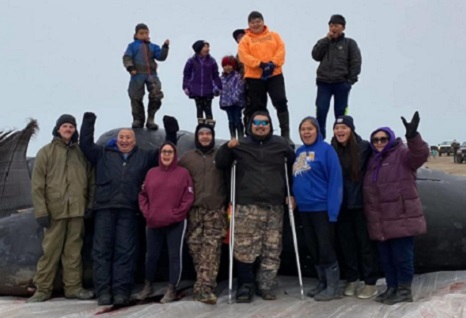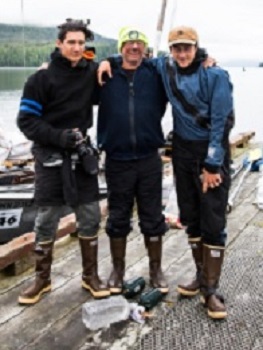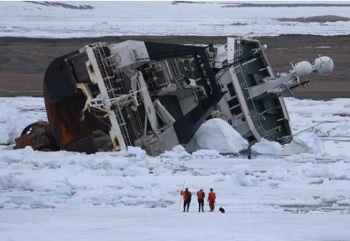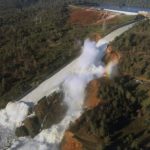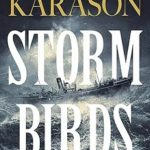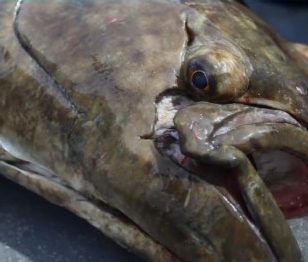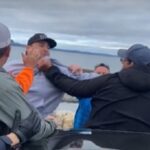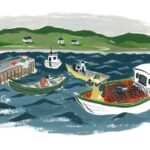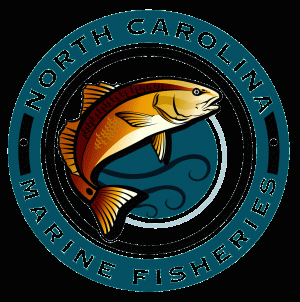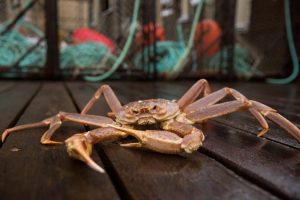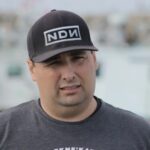Monthly Archives: September 2020
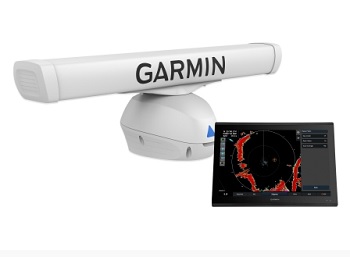
Latest Garmin Fantom Series Boosts Its Market-Leading Power for Solid-State Marine Radars
The new Fantom 254/256 series uses Garmin’s signature MotionScope™ technology to detect and highlight moving targets in different colors, helping users avoid potential collisions, find flocks of birds and track weather. Now with more than double the power of the existing Fantom 124/126, the new Fantom 254/256 solid-state radars yield the best combined short- and long-range target detection performance for serious boaters and anglers. New features, including scan-to-scan averaging and improved MARPA with Automatic Acquisition, provide improved target precision and more visibility of what lies ahead to further a user’s situational awareness on the water. >click to read< 09:57
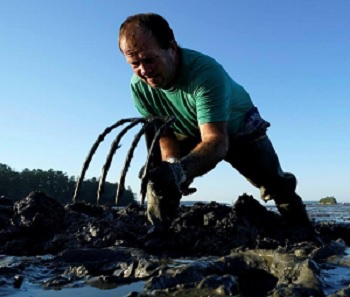
New England clam diggers press through the Coronavirus pandemic
The clamdiggers, who pull softshell clams for use in chowders and clambakes from tidal muck, have weathered an aging workforce, relentless predators that eat shellfish, warming waters and fickle markets. This summer’s pandemic has held back few of the clamdiggers from plying their trade in the coastal clam flats that have fed their customers for generations, members of the industry said. Buyers have rewarded the clammers with prices that have held up better than many sectors of the beleaguered seafood industry, which has suffered a significant economic hit from the pandemic. But some clammers said the disruption wrought by the pandemic has still created yet another difficulty to deal with. >click to read< 07:59
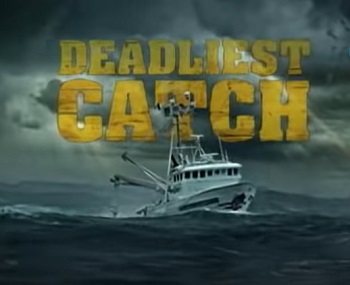
‘Deadliest Catch’: 8 Things You Didn’t Know About the Show
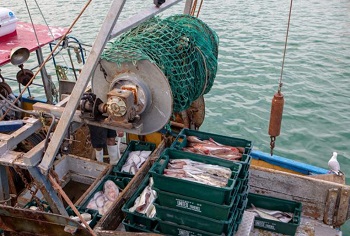
NZ First could put the brakes on the extension of cameras on more boats, depending on outcome of election
New Zealand First has long resisted cameras, but has now agreed with Labour to extend their use. But the party’s fishing spokesperson, Shane Jones, said he would be watching the process closely to make sure it did not handicap the economy. It was important to keep earnings by the primary sector strong, for the benefit of New Zealand as a whole, he said. “The installation of cameras on fishing boats needs to driven by a robust appraisal … and careful analysis of what is the business case (for them),” he said. “In this post Covid environment it is incredibly important that revenue is delivered with gusto. >click to read< 13:50
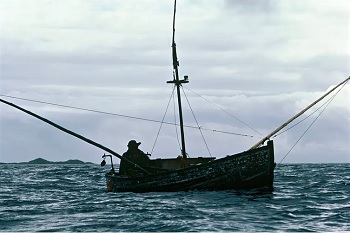
Evolving Business: Bristol Bay salmon fishery dealing with latest challenge, Coronavirus.
Wild salmon return from the ocean to restart a life cycle that has persisted for millions of years. Wild Alaska sockeye (a favorite species of salmon) is caught over the course of a four- to six-week season, from mid-June through July, when the largest remaining wild salmon population returns to Bristol Bay. But the fishermen, seafood processors and communities of Bristol Bay are under threat, and not for the first time. Bristol Bay carries painful memories of the 1918 Great Influenza, which devastated the local indigenous population. Now, the global economy has collapsed in the face of the COVID-19 pandemic, and the market for seafood, often eaten at restaurants, has collapsed along with it.,, And this happens at a time when farmed salmon is an ever-growing part of the industry. (In total conflict with this fishery) >click to read< 10:41

Not Promoting Nuclear Power is hypocrisy. Wind and solar promotors lie about the problems. Lots of problems
Whatever your views on climate change, the idea that trying to run modern, civil societies on sunshine and breezes might somehow prevent it is, of course, a complete nonsense. Nuclear to Replace Wind and Solar – In the words of James Hansen, the scientist most responsible for promoting global warming, wind and solar are “grotesque” solutions for reducing CO2 emissions. Michael Shellenberger, a prominent activist, has the same opinion. Hansen and Shellenberger, as well as many other global warming activists, have come to the conclusion that nuclear energy is the only viable method of reducing CO2 emissions from the generation of electricity. >click to read< 09:14
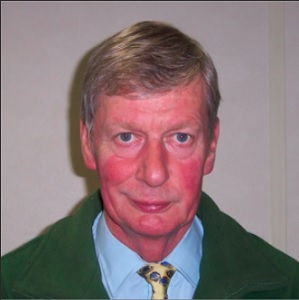
John Ashworth: Why most of the UK’s fish should be landed in the UK
When I watched the fishing debate televised from the House of Commons last Tuesday for the Second Reading of the Fisheries Bill, I was delighted to see many backbench MPs contributing and I was impressed by the level of knowledge shown, except the SNP Fisheries spokesperson who was out of her depth trying to defend the indefensible.,, You have to look back at the direction and progress over the last 30 or so years of campaigning to get out of the Common Fisheries Policy,, John Ashworth has worked all his life in the Fishing Industry, as a gear designer and manufacturer. He spent 20 years working on fishing vessels around the world, and promoted environmental issues, He led the Save Britain’s Fish campaign through the nineties and early twenties and is now part of Fishing for Leave. >click to read< 08:04
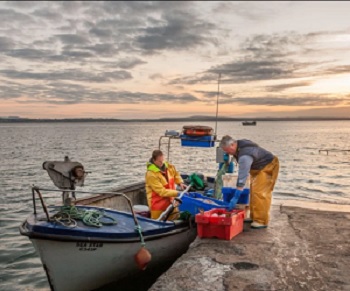
Fishing Rights: Irish fishing group will fight ‘tooth and nail’ against UK quota move
The head of an Irish fishing group has said they will fight “tooth and nail” a move by the UK government to double the catch quota for British fishermen post Brexit. Killybegs Fishermen’s Organisation CEO Sean O’Donoghue described the move as “off the wall stuff” and said it will never be accepted by either the EU or Irish government. Fishing rights have become an integral issue of the UK’s Brexit negotiations, with Boris Johnson’s government seeking to have a huge rise in the quota of British vessels in their waters. >click to read< 14:51

EU humiliation: Brutal reality of Canada deal without UK exposed by Brexiteers
The EU’s celebrated trade deal with Canada has been laid bare after a pro-Brexit organization exposed Ottawa has faced a worsened situation since the UK historically voted to leave the bloc. Facts4EU claims Canada’s trade deficit since signing its joint pact in 2016 with Brussels has worsened by 27 percent, to around -€17.5billion (-£16bn), while the deal will be severely hampered when the UK is finally removed from the bloc. When Canadian Prime Minister Justin Trudeau agreed to the Comprehensive Economic and Trade Agreement (CETA), the trade deficit was at -€13billion (-£11.6bn), Facts4EU say. The organization say the deal with the EU will become “a whole lot less” as Canada sold 43 percent of its goods to the UK, and that when Brexit is concluded it will not enjoy such high levels of trade. >click to read< 12:35
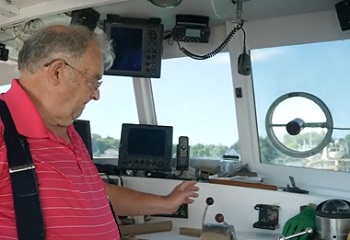
Maine lobsterman who doesn’t have internet is a rising star on YouTube
Leroy Weed has seen it all. He’s seen lobsters in a rainbow of colors. He’s been onboard a boat that’s sunk (extra scary, because he says he can’t swim). He’s fallen through the ice in the dead of winter — twice. And yet, Weed, 79, says the ocean still holds plenty of surprises for him — even after 70 years out on the water, ever since he started hand-hauling traps with his father when he was 8 years old. Last summer, Weed put that expertise to use when he joined the staff of the Maine Center for Coastal Fisheries. This summer, with the touch tank closed due to the pandemic, the center wanted to make sure Weed still had a chance to connect with people who want to learn more about Maine’s coastal waters and working waterfronts. They approached Weed with a novel idea, to star in a weekly series of YouTube videos called “Ask Leroy!”, in which people call (224-58-LEROY) or email with questions, and Weed answers them. >Videos, click to read< 09:57
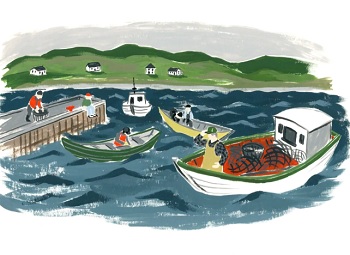
Parallels: What does Coronavirus pandemic have in common with the 1992 cod moratorium?
Barbecues, swims in cool waters and the warm summer breeze — typical beats of summer across Canada, even in 1992. That year’s summer meant a seismic shift for about 40,000 people in Newfoundland and Labrador. In an unprecedented move, due to the depleting numbers of northern cod, the federal government announced a moratorium on the cod fishery. It was a dark day in Canadian history, the moratorium sent a shockwave through Newfoundland and Labrador, ripping its people from the sea, its impact still ringing through time.,, For generations, the cod collapse has affected lives in Newfoundland and Labrador. Much like today, jobs were lost overnight and people were forced to stay at home. >click to read< 08:03
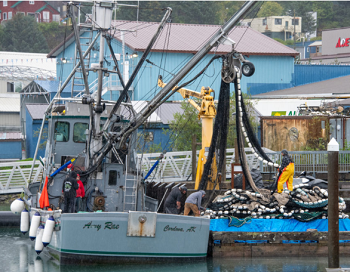
Prince William Sound coho, chum, sockeye harvests still rising
Even as the 2020 season is winding down, the catch of coho, chum and sockeye salmon is rising in Prince William Sound. Preliminary statewide harvest numbers compiled by the Alaska Department of Fish and Game showed that as of Wednesday, Sept. 2, the commercial catch for Prince William Sound had reached 24.3 million salmon, including some 21.3 pink, 1.9 million chum, 937,000 sockeye, 130,000 coho and 4,000 Chinook. The latest figures showed a boost of 95,000 humpies, 30,000 coho and 1,000 sockeyes since ADF&G’s Sept. 1 preliminary report. The Copper River District meanwhile was open for a 24-hour commercial fishing period on Thursday, Sept. 3. >click to read< 19:12
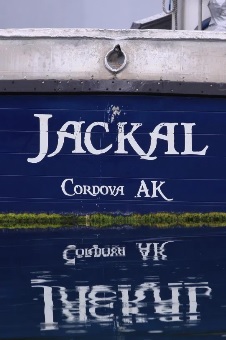
Around The World: Fishing For Cordova Salmon
Located on Prince William Sound in southeast Alaska and framed by the Chugach Mountain Range, Cordova, AK, was home to Eyak native peoples when named “Puerto Cordova” after a Spanish admiral by explorer Salvador Fidalgo in 1790. In 1886 the New England Fish Orca Cannery was built three miles north of present-day Cordova. It at one time processed most of Prince William Sound’s salmon harvest and employed hundreds of workers. It remained in operation until 1986.,, Priced at about $175,000 apiece, around 500 salmon fishing permits are issued every year in Cordova. They are divided into three categories: drift gillnets, set gillnets, and purse seines. photos, >click to read<, To view past articles and pictures, go to www.DaveGibsonImages.com. 14:17

Federal judge rules fishery managers failed to prevent overfishing of northern anchovy
A federal judge has ruled that the National Marine Fisheries Service (NMFS) must go back to the drawing board and redo the catch limit for northern anchovy — an important food source for whales, sea lions, brown pelicans, and salmon. Judge Lucy M. Koh ordered the agency to issue a new rule within 120 days that accounts for the drastic fluctuations in anchovy populations and prevents overfishing when the stock is low. >click to read< 09:33
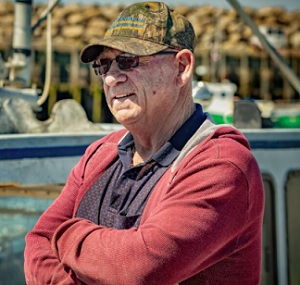
Mi’kmaw lobster harvesters feeling harassed for practising moderate livelihood fishery
Mi’kmaw lobster harvesters in southwestern Nova Scotia say they feel harassed by non-Indigenous harvesters for practicing their treaty right to earning a moderate livelihood by setting lobster traps in St. Mary’s Bay. The harvesters say the harassment isn’t only coming from non-Indigenous harvesters. They’ve also had their gear seized by officers with the Department of Fisheries and Oceans. >click to read< 08:14

1 in 200 million! Young Massachusetts lobsterman catches a blue lobster! “I was shocked.”
Adam Carpenter couldn’t believe his eyes. As he opened the lobster trap, he could see one of the crustaceans was visibly different from the others. The 13-year-old kept rubbing his eyes to make sure it wasn’t a mistake. Yep, one of the lobsters was definitely blue. “I’d seen YouTube videos of blue lobsters before but never thought I would catch one,” said Adam, who just got his lobster license this summer. “I was shocked.” On Friday, Adam went out to check one of the pots he had missed on his last few trips. When he pulled this one up, he got the surprise of his life. >video, click to read<17:34

Fishing and football is a full life for Perry
Jimmy Perry is a hard working football coach and commercial fisherman, who was born in Naples. Always having a passion for time afloat, he has been fishing since the age of 5. He owns and operates Big Jimmy’s, a small business that provides customers from Immokalee to Okeechobee, and everywhere in between, with delicious, locally caught, fresh fish, shrimp and crabs. When asked about the perks of crabbing and commercial fishing, he said, “My favorite part of what I do is watching the sunrise every morning.” As for the hard parts,,, >click to read< 11:26
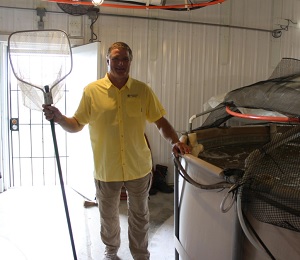
But, there is no sea in Kansas! Fresh Seafood In Landlocked Kansas? ‘I Can’t Grow It Fast Enough.’
When Bob Daniels started telling people he wanted to start a shrimp farm in the middle of Sumner County, the response was what you might expect. “‘You’re going to sell bait, huh?'” he said laughing while recalling one comment. “In fact, when we started looking to grow the shrimp and look for some financing … the local banker said, ‘Well, you’re never going to sell this.’ “Now, it turns out, I can’t grow it fast enough to sell what people were willing to buy.” >click to read< 10:22
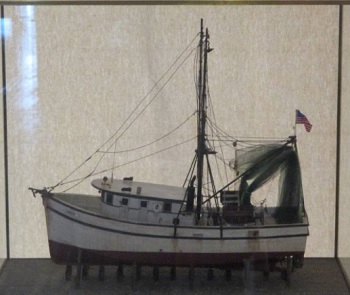
Where is the Jenny? Exhibit tells story of famed Beaufort shrimp boat from ‘Forrest Gump’
Tom Boozer knows almost everything about the shrimp boat that was plucked from Beaufort waters more than 25 years ago and set on a course for Hollywood fame. Everything, that is, except where the vessel is now. The 55-foot trawler Miss Sherri, then owned by Beaufort shrimper Jimmie Stanley, became the Jenny as christened by actor Tom Hanks’ character in the smash hit “Forrest Gump,” filmed in Beaufort.,, McIntyre and Boozer didn’t know what became of the trawler. The boat had been rumored to be sinking in the water where it was displayed and the men feared it had been removed and scrapped. But a Planet Hollywood spokeswoman said the Jenny still lives. >photos, links, click to read< 08:48
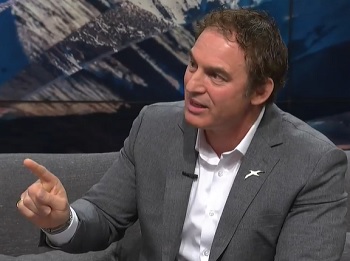
New Zealand Government to pay up to $60 million to install cameras on commercial fishing boats
Minister of Fisheries Stuart Nash has announced a large cash investment from the Government to roll out cameras on commercial fishing vessels. The cameras will be used to monitor any breach of fishing quotas by operators. Nash said the funding would make a real difference, but defended the delay in making it happen. “This isn’t simply a matter of just about getting a go-pro and a selfie stick and away you go, we’re talking about cameras that are operating in the harshest of environment, we’re talking about up to 700G of data that has to be transferred from the boat per month, from the boat to some sort of storage site, it has to be viewed. >click to read< 20:35
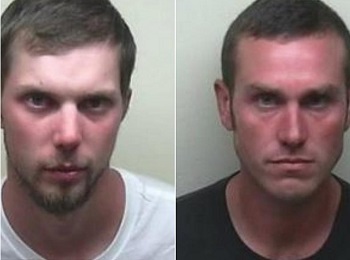
The two men accused of killing Franky the Pug are disputing the charges.
Justin Chipman and Nathan Burke were arrested on multiple charges after they allegedly broke into Phil Torrey’s home in 2018 and stole his hummer, taking his pug dog Franky along for the ride. At some point, Franky was shot and killed. His body was found, wrapped in plastic, on a Winter Harbor beach six days later. Chipman and Burke had once worked as sternmen on Torrey’s lobster boat. >click to read< 17:13
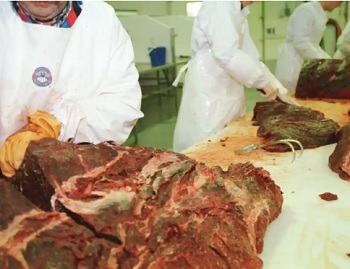
Demand for whale meat in Norway rising after years of decline
Norway remains one of only three countries to publicly allow commercial whaling, along with Japan and Iceland. Much of the catch is sent to Japan, where demand is high, but for the first time in years businesses have reported increased interest in eating whale meat domestically. Four hundred and eighty-four minke whales have been killed so far this year, which is fewer than half the annual quota of 1,278. Last year’s total of 429 whales caught was the lowest in decades. The fleet has also been in decline, with only 12 vessels participating in this year’s hunt, down from 34 in 2004. Odd Emil Ingebrigtsen, Norway’s fishing minister, said: “It is very positive that we are witnessing an increase in both catches and demand for products this year. >click to read< 14:04
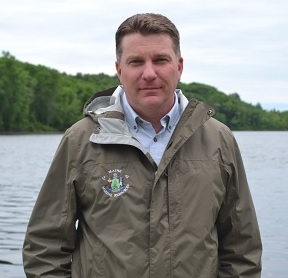
An Update from Commissioner Keliher Regarding CARES Act Funds
Over the past few days I have received several calls from harvesters and the press asking about the CARES Act relief money. It seems that some are putting it out on social media that “The State is keeping the money” or “It’s only going to support aquaculture.” One individual asked me, “How are we supposed to know what is happening when no one tells us anything?” That statement shows me that the webinars and conference calls we’ve had to rely on can’t replace in-person communications. Regarding the CARES Act money,,, >click to read< 12:46

Fishermen, state leaders push back against at-sea monitoring proposal
The New England Fisheries Management Council (NEFMC) is considering Amendment 23 to the Northeast Multispecies Fishery Management Plan (FMP) that would require groundfishing vessels to implement 100% at-sea monitoring or a blended approach of at-sea monitoring and electronic monitoring. The proposed change seeks to improve catch accountability in the fishery, but fishermen argue this particular proposal is overly burdensome and unnecessary to achieve the stated goal,,, Overall, fishermen across Massachusetts fear this proposed policy would incur overly burdensome costs on an already struggling fleet, accelerating the expiration date of the fishery.” >click to read< 11:52

Stephen C. Dexter – Being a self employed fisherman was the finest kind to him.
We sadly lost a valuable member of the community on the evening of August 24, 2020 when Stephen C. Dexter, 70, favorably known as “Critter”, passed away after a courageous four-year battle with cancer. Critter grew up in North Yarmouth, graduating from Greely High School in 1968. He was an easy-going and caring soul. His even-keeled nature had a way of drawing people to him. He was thought of as a beloved friend and father to many. Being a self-employed fisherman was the finest kind to him. Always up well before the sun, hard work was a part of his daily life. He started lobstering in the 1970s out of the Stripper 1. From there he went tuna fishing, dragging for scallops and shrimp, and then spent the majority of his fishing career lobstering off of Sequin Island out of the Kristin Leigh. >click to read< 09:19
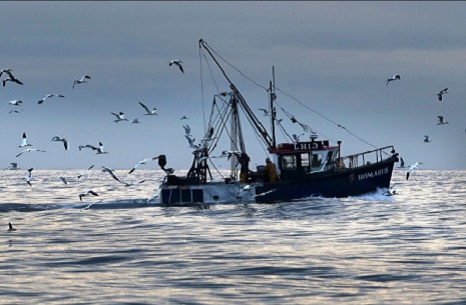
Why Brexit will be fishing industry’s salvation
When I am out and about in Grimsby, the most commonly asked question I get is: “When are we going to get our fishing waters back, and are we going to get them back?” I say to my constituents: “Yes, absolutely.” Grimsby’s association with the fishing industry goes back centuries, but the modern industry started in the 1800s. By 1900, 10 per cent of all the fish eaten in the UK was landed in Grimsby. What fishing brought to Grimsby was wealth, investment into the docks and a direct train link to London. That was the power of the fishing industry to us. Unfortunately, that industry has been taken away from us, first because of the cod wars with Iceland, impact of the Common Fisheries Policy,,, By Lia Nici >click to read< 08:20
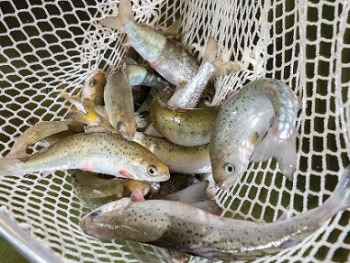
Land-based salmon farm proposed for Chesapeake’s Eastern Shore
AquaCon executives intend to build a $300 million indoor salmon farm on the outskirts of Federalsburg in Caroline County. By 2024, they aim to harvest 3 million fish a year weighing 14,000 metric tons — an amount on par with Maryland’s annual commercial crab catch. If that goes as planned, the company expects to build two more land-based salmon farms on the Shore over the next six or seven years,,, Another Norwegian company is preparing for its first full harvest later this year from a facility south of Miami, and plans have been announced to build big indoor salmon farms in Maine and on the West Coast. Two small U.S.-based salmon operations in the Midwest also are moving to expand production. >click to read< 07:12






